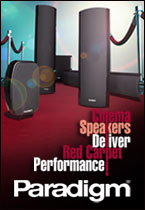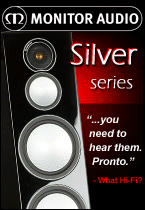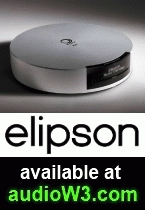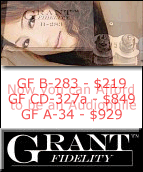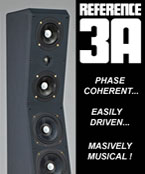ModWright Instruments may not be a familiar name to you. If it is, you may know the company for its custom work in improving the sound of various popular CD and video players. But quietly this twelve year old company, under its founder Dan Wright, has introduced a range of products, starting with tube preamplifiers, then power amplifiers (silicon based) and most recently a powerful integrated amp.
We are taking a look today at the most expensive amp in the range, the new Signature Edition of the powerful KWA 150 power amp (originally introduced in 2009). It is available in two ways, either as a factory upgrade to the standard KWA 150 or as a new model in its own right, the KWA 150 Signature Edition (SE). You can specify silver or black finish. Either way you’re going to need a very strong shelf and plenty of room – this thing’s a bruiser, around 37 kilos of muscle. It’s also a looker, with the ModWright name superbly sculpted into the top panel and into the large front mounted on-off switch, the focus of a beautifully finished chassis.
For an amp of this price ($9,000) and this size (43 cm x 43 cm x 22 cm) the maximum quoted output power of 150 watts per channel into 8 ohms may seem modest, but there’s more to an amp than rated power, just as horsepower alone doesn’t tell the full story in a sports car. Just as peak torque is an equally important measure for engines, peak current delivery is a key measure of an amp, and the KWA 150 SE has this in spades. As a result, it’s well suited to driving a huge range of speakers that might cause some other powerful amps to struggle. In fact this amp almost doubles its output into 4 ohms, and if you use one amp per channel in bridged mode then the peak output climbs to 450 into 8 ohms or 650 wpc into 4 ohms. That’s a lot of grunt.
ModWright is a company that eats its own dogfood, by which I mean that it actually manufactures the all-important capacitors that provide the huge reserves of power to meet massive transient peaks. That’s the equivalent of a speaker manufacturer building its own drivers, and gives an indication of how serious and knowledgeable these guys are. This revised capacitor bank is in fact the most significant change as you move from the standard KWA 150 to the Special Edition. Instead of 4 large capacitors per channel we now have 16 smaller devices, resulting in better speed, transparency and detail. Other changes include a better specified transformer on the balanced inputs, upgraded Cardas internal wiring and a revised input section to provide a lower noise floor and reduced levels of distortion.
I guess I’ve been watching too many episodes of Criminal Minds. If I can play profiler for a moment, I’d say you are very serious about music, and you’ve tried a number of different amps that have left you feeling something was missing. Perhaps you find the listening fatiguing after an extended period. You have a large and varied music collection and the speakers you are using pose something of a difficult load to an amplifier, either in terms of a low impedance, a heavy current draw, a low efficiency rating or some combination. You’ve heard a system somewhere else that tells you how good things can be, but despite paying a lot for your current setup, you’re not there yet.
You’re a head banger. You don’t believe high resolution sources (Vinyl, SACD, 192/24) are noticeably better than Redbook CD. You want to impress your neighbours with brand names like Mark Levinson and Krell. You spend less on your front end than you do on your power amp and your music collection is concentrated around one or two musical genres, mostly involving amplified instruments.
At first, you may think something is wrong. You turn the amp on by pressing the giant centrally mounted logo and blue lights start flashing immediately. This is just to warn you that it’s not ready yet – a soft start feature that mutes the output for close to 60 seconds while the amp settles down. Even then you should not expect optimum performance until it has become thoroughly warm. That may take an hour or so, and warm means close to body temperature on the heat-sinks. This is in the recommended high bias mode, selected by a rear mounted toggle switch. You may choose to keep the amp on at all times as I do to eliminate this warm up period. If you are worried about your electricity bill, and who isn’t these days, toggle to low bias when you are not listening for a while. On/off and high/low bias are the only controls you will ever adjust. There are also a couple of set and forget switches on the back panel - one to switch between a stereo amp and a bridged mono amp, the other to lift the ground if you can hear a hum.
I put the amp through its paces with the most transparent and revealing components I could get my hands on – EMM Labs XDS1 SACD player, EMM Labs Pre2 preamplifier and YG Carmel speakers all connected up with Nordost Valhalla cabling.
So what are the sound characteristics of this heavyweight? It’s hard to say, since it appears to add nothing of its own to the sound and takes very little away. It boasts lightning reflexes, enormous dynamic range, a silent background, vanishingly low distortion levels and a rich palette. Now these characteristics are an absolute requirement at this price, but there’s more. It does an astonishingly good job in two areas not every high priced amp can cover. Firstly, imaging is simply wonderful, every instrument firmly in place, which makes it so much easier to make sense of really complex music. Secondly, the quality of the sound, its speed, definition, colour and power is fully maintained right across the frequency spectrum, from the deepest bass to the highest notes. Now that is something to write home about. The better the partnering equipment, the more important these last two qualities will prove, since they are often lacking in all but the very best CD players, preamps, speakers and cables.
One particular aspect of the sound deserves to be singled out. The treble is very detailed and extended, and this can often lead to listener fatigue, particularly with an overly bright or gritty tweeter. Many amps shade down the high frequencies for a less objectionable sound with typical speakers, offering a smooth rounded sound similar to some tube amps. That is not the case here. The high end is crystal clear and full of air but without any hard edge to it. Paired with the superb tweeter in the YG Carmel we get a really lifelike top end, shimmering cymbals and extended harmonics on the wind instruments and voices, but not a hint of brightness. It just strikes you as open and natural, like fine acoustic music in a great hall.
It’s all about finesse, instrumental colour and holographic imaging. The ModWright exercises supreme control over wayward speakers, digs into the finest detail and is spectacularly even handed at all frequencies and decibels. It’s also an unforgiving amp. I wouldn’t go so far as to say brutally honest, but if your system includes a source or a preamp which produces colourations, you’re going to hear them amplified and reproduced with great clarity. So partner this amp with components of an equally high order right through the listening chain.
I threw many different types of music, from acoustic jazz to hard rock and opera to Leonard Cohen’s latest offering Old Ideas. It feels equally at home at all times, capable of immense power in Shostakovich’s Tenth Symphony (Naxos) and delicate detail in Blackbird as the occasion demands. It’s a pleasure to find a power amp equally at home at both extremes of the decibel range but it’s the same dynamic qualities, the ability to throw a deep stable image and the high levels of resolution and phase accuracy that make both extremes shine. If there is a weakness, other than the small matter of the deep pockets required, it’ll need more refined ears than mine to identify it.
This is a combo that just gets out of the way of the music, which simply pours through from disc to ear without impediment in the test setup. This power amp is easily the least expensive component in the room, yet it is also a perfect match to its distinguished partners. I also tried a variety of other speakers, some much more difficult to drive, and the amp never put a foot wrong with any of them - it sure plays well with others.
The KWA 150SE is massively built and contains components of the highest quality and reliability in a configuration that will never stress them to the limit. That enables ModWright to slap a five year warranty on the box. If something ever does go wrong, you can rely on the good people at ModWright’s Canadian distributor Tri-Cell to take good care of you.
Normally, you might never see a power amp, in which case it can be plain ugly. As long as there’s adequate ventilation you can just hide it somewhere at the back. But this particular one is so large it’s likely going to show. Fortunately ModWright lavished as much attention on the exterior as they have on the interior and it looks good at centre stage.
You have to hand it to a company that can establish such a serious reputation in so short a time. ModWright’s tube based preamps have set new standards at their price points, and the range of four power amps has created quite a buzz in an industry where many are struggling. Dan Wright’s extensive knowledge of circuit topology and individual components, honed by the business of upgrading other companies’ products and the development of the KWA 150, KWA 100 and KWA 100SE amps has culminated in this very fine achievement - an amplifier which even at its elevated asking price represents a fine audio investment.
ModWright Instruments
www.modwright.com
Distributed in Canada by Tri-Cell Enterprises, www.tri-cell.ca
1-800-263-8151
ModWright Instruments KWA 150 Signature Edition Amplifier
Price: $9,000 CAD
Click here to discuss this article on the CANADA HiFi Forum






